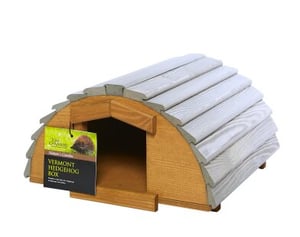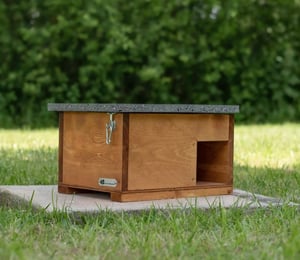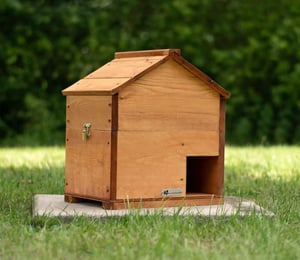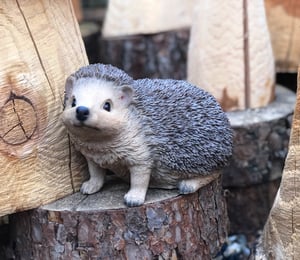How to Attract Hedgehogs Into Your Garden
Hedgehogs are such beautiful creatures and always welcome visitors, interesting to observe and useful predators of garden pests, David Hall describes how you can attract them into your garden.
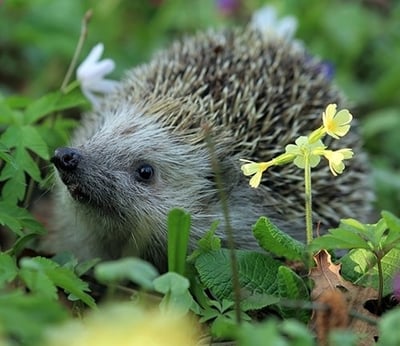
Hedgehogs are such beautiful creatures and always welcome visitors, interesting to observe and useful predators of garden pests, David Hall describes how you can attract them into your garden.

Unfortunately, the hedgehog population is declining markedly each year, so encouraging hedgehogs into your garden and looking after them is important if you value wildlife and the benefits that they bring to our world.
To be successful in attracting Hedgehogs to our gardens we have to first look at our garden overall and create an environment that they feel at home in. In this instance, you can forget about manicuring the whole of the garden, leave an overgrown patch with logs, leaves and prunings for the Hedgehogs to rustle through. Also, ensure that they can roam freely in adjoining properties by leaving a small gap if your garden is surrounded by fencing as they can forage for long distances and fences can be insurmountable barriers.
What you don't want to leave around your garden includes cans that aren't crushed, those plastic loops that hold them together, bottles and cartons. Wire mesh, barbed wire and netting are also hedgehog death traps.
Be careful with insecticides and other pesticides including slug pellets, if hedgehogs eat the corpses of garden pests they'll also ingest the poison. Buy wildlife friendly brands that are easily obtainable.
Remember to clean up any spillages in the shed, you don't want noxious substances seeping through the boards onto any hedgehogs below.
When you're gardening, watch out for hedgehogs in the long grass. Strimmers and lawn mowers aren't hedgehog friendly at all.
Although hedgehogs can swim make sure they can extricate themselves from ponds by having sloping sides and from swimming pools by hanging a length of chicken wire over the edge.
Cover up any open drains, hedgehogs can fall in and might not get out. If you enjoy the November 5th festivities or use bonfires to get rid of garden rubbish, check for hedgehogs first before lighting them. They like a warm place to nest but not that hot. It's also worthwhile checking a compost heap before digging into it with a spade.
Discovering what they do eat will give us an indication of the best way of feeding hedgehogs ourselves. Beetles, larvae and caterpillars seem to be top of the hedgehog menu, closely followed by earthworms, millipedes and earwigs. Before you get to slugs and snails there’s eggs and small dead mammals!
Slugs and snails seem to only occupy 5% of a hedgehog’s diet. They are eaten as a last resort due to one very good reason. The slimy gastropods carry lungworms. These pesky parasites are passed onto the hedgehog and can be fatal, causing respiratory problems and death. Because of this, hedgehogs will only eat a lot of slugs and snails when there isn’t much else available. Feeding hedgehogs is therefore important if they are to avoid lungworm infestation.
Food and water can be left out all year round, if hedgehogs can't find food during the summer they're liable to fall victim to parasites and disease and they need to put on weight to see them through hibernation. Even when hedgehogs are hibernating they may wake up and need nourishment.
Dog or cat food that doesn't contain fish is ideal. Choose the better brands that aren’t packed out with cereal, but, as hedgehogs are omnivores, there's lots of other food they'll eat in addition to the specially prepared hedgehog food that's also available.
Any cooked leftover chicken, lamb, turkey or beef (without gravy) will be eaten, but avoid salty bacon. Chopped unsalted peanuts and sultanas are good together with most vegetables, bananas, apples, mango but not citrus fruits. Chop the food up as hedgehogs cannot chew or easily tear up large pieces.
Provide plenty of water but do not leave out bread and milk. Food and water should be left out all year round, even when hedgehogs are hibernating they may wake up and need food if you go on holiday ask a neighbour to help. If hedgehogs can’t find food during the summer they’re liable to fall victim to parasites and disease and they need to put on weight to see them through hibernation.
Do not feed hedgehogs with milk or bread, the former can’t be digested properly and can lead to dehydration and death, while the latter even in large quantities contains little useful nutrition. Hedgehogs are also lactose intolerant.
The best time for feeding hedgehogs is at night. This makes sense in two ways: a) they’re nocturnal and b) flies won’t be attracted to the meat (their maggots can cause serious harm to hedgehogs). Any food should be removed in the morning and the dish washed ready for the evening.
Feeding hedgehogs is therefore essential if they are to avoid lungworm infestation. As they're omnivorous the list of snacks you can leave out is fairly lengthy. Every food needs to be chopped up finely as hedgehogs cannot chew or tear up large pieces. It's also best to place food in a shallow dish that won't tip over.
Similar to people, they prefer a dry, cosy place to live, especially in the winter when they like to shut the cold weather out and hibernate. In the wild hedgehogs will collect leaves, grass, bracken and other material to build nests under hedgerows or logs. In the garden, they may set up home under your shed or compost heap.
To encourage hedgehogs into your garden, you can buy a hedgehog house and there are also other garden mammal houses to choose from. The Wildlife World Hogilo Hedgehog House is a shelter for our spiny friends who do such a good job hoovering up unwanted snails. There's a 'breathable' interior so there are no condensation problems and the large inspection hatch means easy cleaning and it's also raised off the ground to prevent rotting. It's predator resistant and has as a safe feeding 'lounge'.
Wildlife World also manufactures their Igloo Hedgehog House which has a very strong double skinned and barrelled roof and is made from white oak and other durable woods for good insulation. An entry tunnel leads to the house that also has a hinged back door for cleaning purposes. It also has ventilation holes at the rear and is raised off the ground by runners to help keep it dry.
The Brushwood Hedgehog Haus has a wire frame lined with a waterproof material covered by a camouflaged earth and twig-like roof which is actually made of durable rot-proof material. It simply sits on the ground under a shrub or tree and looks very natural. It also features an entrance porch that help deter predators whilst making hedgehogs feel at home. It is one of our best selling hedgehog houses.
Alternatively, build one yourself, a stout wooden crate perhaps 18ins square is a good starting point, but don't use any wood that has been creosoted. Take a jigsaw and cut an entrance at the base of one side measuring about 6ins x 6ins. Drill a hole wide enough for a hose at the top of one side. Place the box on two bits of wood or something similar to raise it slightly off the ground. After lining the inside with dry leaves and newspaper, secure a removable lid to the top, this can be made of anything that is weatherproof.
Attach a tunnel made from timber and about 12ins long to the entrance. Put a length of hose through the hole that you drilled for ventilation. Give a nest box protection from the elements by covering with leaves and plastic sheeting (keeping the entrance clear and with any ventilation hose going through the plastic and pointing down).
Hedgehog houses should be located in a quiet part of the garden, preferably against a wall or fence. The entrance should face south to avoid cold northerly winds. A few leaves and bracken scattered on top and nearby will help them feel at home. You can also place some hedgehog food and a bowl of clean water nearby with some short dry grass inside to encourage them in.
It might be a while before any hedgehogs take up residence. If you have had no luck for a couple of years, think about relocating the house to a more favourable place.
In the spring any hedgehogs should emerge looking for food. After they have checked out of the hedgehog house you can clean up after them using Pyrethrum, sometimes called nature's insecticide. The hedgehog house will then be ready for its next family to move in.
Gardens are incredibly important habitats and if you want to encourage wildlife and help combat a worrying depletion of native fauna, there are a number of insect and animal boxes that will attract a wide variety of insect and mammals.
In most cases, Hedgehogs are just going about their daily business and are best left to their own devices. Of course, they might curl up into a ball, which is a natural defence mechanism, before moving on. However, if you are concerned about a found hedgehog because it is injured, distressed or very small and lost you may need to react. Always pick up a hedgehog using strong gloves, for obvious reasons, and place them in a cardboard box which has high enough sides so they don't easily escape. Add some material bedding for comfort along with some fresh water in a shallow bowl. You can also offer some meaty cat or dog food or small bits of bacon or even some crushed unsalted nuts. Place them in a warm, but not overhot room or an unheated room with a hot water bottle. Make sure the bottle is not too hot and wrapped in an old towel or similar and topped up before it becomes too cold. Make sure there is room for the hedgehog to move away from the bottle if required.
You can then call the British Hedgehog Society on 01584 890 801 for further advice. If your call is out of hours press option 1 for further advice.
Looking after hedgehogs isn’t rocket science, all they need is a warm nest and nutritious food, they’ve been around for 15 million years so we don’t want to lose them now. For more detailed information including what to do if you find a hedgehog contact The British Hedgehog Society.
For Further Information
Visit some of our other wildlife blogs:
How To Attract Birds To Your Garden How To Attract Wildlife To Your Garden How Can I Help To Save Our Bees?
Shop Now £49.99
Shop Now £57.99
Shop Now £79.99
Shop Now £61.99
Shop Now £26.99
Shop Now £84.99
Shop Now £29.99
Shop Now £29.99




